In the world of luxury fashion, identifying overpriced handbags requires a keen eye for detail and an understanding of market dynamics. By examining brand reputation, material quality, and current pricing trends, you can discern whether a handbag’s cost is justified. Additionally, recognizing signs of counterfeit products, such as poor craftsmanship and inconsistent branding, is essential for making informed purchasing decisions.
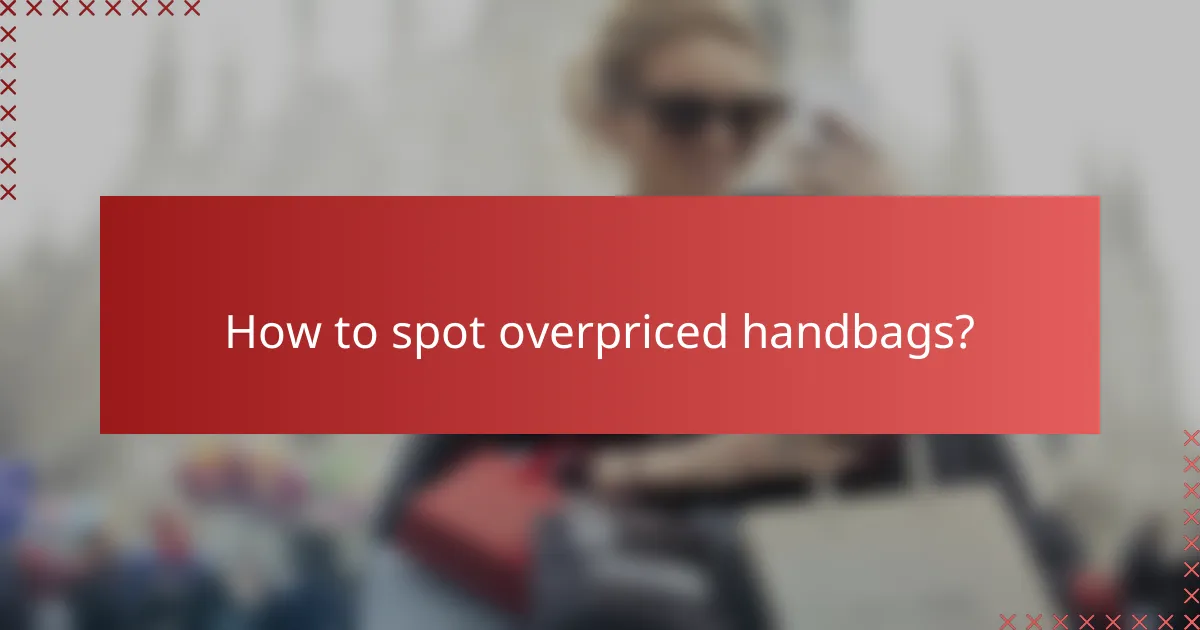
How to spot overpriced handbags?
To spot overpriced handbags, examine the brand, materials, and market prices. Understanding these factors can help you determine whether a handbag’s price is justified or inflated.
Identifying brand markups
Brand markups occur when a handbag’s price is significantly higher due to its label rather than its intrinsic value. Luxury brands often charge premiums based on their reputation, exclusivity, and marketing. For example, a handbag from a well-known designer may cost several hundred to thousands of dollars more than a similar style from a lesser-known brand.
To assess brand markups, research the brand’s history and market position. Compare similar styles from different brands to see if the price difference aligns with the perceived value.
Assessing material quality
Material quality plays a crucial role in determining a handbag’s worth. High-quality materials such as genuine leather, silk, or durable synthetics typically justify higher prices. Look for details like stitching, lining, and hardware, as these can indicate the craftsmanship involved.
To evaluate material quality, feel the fabric and inspect for any imperfections. A well-constructed handbag should have a sturdy feel and no loose threads or uneven seams.
Comparing prices across retailers
Comparing prices across various retailers is essential for identifying overpriced handbags. Prices can vary significantly, even for the same item, due to different retail strategies and promotions. Use online platforms to check prices from authorized retailers and reputable second-hand shops.
As a rule of thumb, if a handbag’s price is consistently higher than the average market price by a notable margin, it may be overpriced. Keep an eye out for discounts or seasonal sales that can provide better deals.
Evaluating resale value
Resale value is a key indicator of a handbag’s worth. Handbags from reputable brands often retain their value better than others. Research resale platforms to see how similar handbags are priced and how quickly they sell.
A handbag that depreciates significantly in value may indicate an inflated initial price. Consider investing in brands known for their strong resale markets, as this can be a sign of quality and desirability.
Checking authenticity
Authenticity is vital when assessing a handbag’s price. Counterfeit handbags can be sold at high prices, misleading buyers. Look for authenticity cards, serial numbers, and distinctive brand features that are difficult to replicate.
When in doubt, consult expert authentication services or guides specific to the brand. Ensuring a handbag is genuine can protect you from overpaying for a counterfeit item.
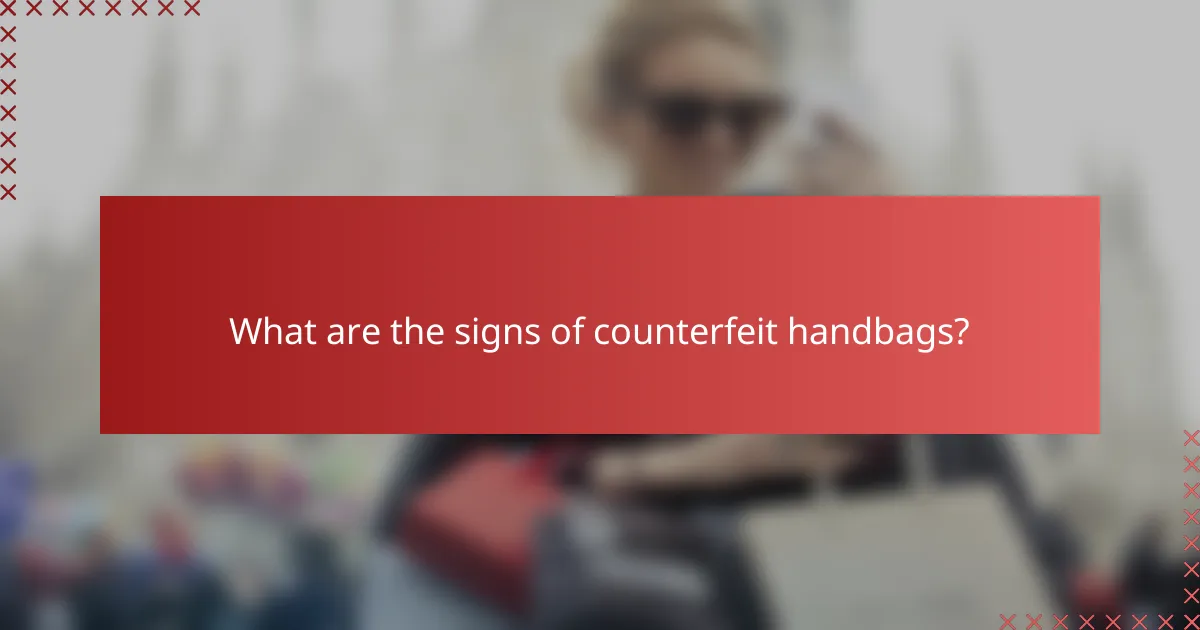
What are the signs of counterfeit handbags?
Counterfeit handbags often exhibit several telltale signs that can help you identify them. Key indicators include poor craftsmanship, inconsistent branding, and unusual packaging, all of which can signal that a handbag is not genuine.
Poor stitching and craftsmanship
One of the most noticeable signs of a counterfeit handbag is poor stitching. Authentic luxury bags typically feature precise, even stitches, often with a high stitch count per inch. If the stitching is uneven, frayed, or missing in areas, it’s likely a fake.
Additionally, examine the materials used. Genuine handbags are made from high-quality leather or fabric, while counterfeit versions often use cheaper materials that feel different to the touch. Look for any signs of glue or excess material, which can indicate a lack of attention to detail.
Inconsistent logos and branding
Counterfeit handbags frequently have logos that are misaligned, misspelled, or poorly replicated. Authentic brands maintain strict quality control, ensuring that their logos are consistently placed and accurately designed. If you notice any discrepancies in the logo’s font or color, it’s a red flag.
Check for brand-specific features, such as unique hardware or patterns. Familiarize yourself with the authentic product line to spot variations that shouldn’t exist. For instance, if a brand typically uses gold hardware but the bag has silver, it may not be genuine.
Unusual packaging
The packaging of a handbag can also indicate its authenticity. Genuine luxury handbags often come in high-quality dust bags and boxes that feature the brand’s logo. If the packaging is flimsy or lacks branding, it’s likely a counterfeit.
Additionally, consider the included accessories. Authentic bags may come with care cards or authenticity certificates, while fakes often lack these details. Always inspect the overall presentation to ensure it matches the brand’s standard.
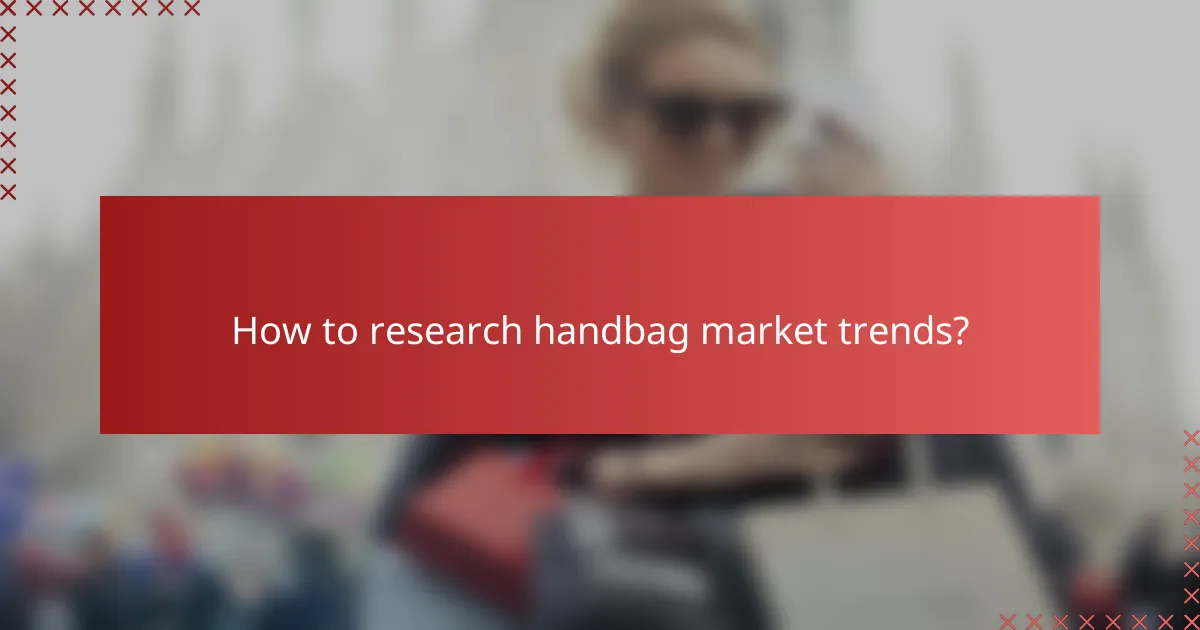
How to research handbag market trends?
Researching handbag market trends involves analyzing various sources to understand consumer preferences and pricing dynamics. This knowledge helps identify which handbags are overpriced and which are worth the investment.
Using fashion trend reports
Fashion trend reports provide insights into upcoming styles, colors, and materials that are gaining popularity. These reports often highlight key brands and designers, allowing you to gauge which handbags are likely to appreciate in value.
To utilize these reports effectively, focus on those published by reputable fashion forecasting agencies. Look for seasonal reports that cover both high-end and accessible brands, as this will give you a comprehensive view of the market.
Following influencer recommendations
Influencers play a significant role in shaping handbag trends through their endorsements and personal styles. By following influencers who align with your taste, you can gain insights into which handbags are currently in demand.
Pay attention to the engagement levels on their posts, as high interaction often indicates a strong interest in the featured products. However, be cautious of sponsored content; always consider the authenticity of the recommendation.
Analyzing social media buzz
Social media platforms are valuable for gauging public interest in specific handbag styles. Use tools like hashtags and trending topics to discover which bags are generating conversations among users.
Look for patterns in comments and shares to identify which handbags are perceived as valuable or overpriced. Engaging with communities on platforms like Instagram and TikTok can also provide real-time feedback on market sentiments.

What are the most common overpriced handbag brands?
Some of the most common overpriced handbag brands include Louis Vuitton, Chanel, and Gucci. These brands are known for their high price tags, often due to their luxury status, craftsmanship, and brand heritage.
Louis Vuitton
Louis Vuitton is renowned for its iconic monogram and high-quality materials, which contribute to its premium pricing. Handbags from this brand can range from a few hundred to several thousand dollars, depending on the style and rarity.
When evaluating a Louis Vuitton handbag, check for authenticity by examining the stitching, hardware, and date codes. Counterfeit items often have uneven stitching or incorrect logos, which can be red flags.
Chanel
Chanel handbags, particularly the classic flap bags, are often seen as status symbols and can command prices in the thousands of dollars. The brand’s limited production runs and timeless designs contribute to their high resale value.
To spot an overpriced Chanel bag, look for signs of wear and authenticity. Genuine bags will have a serial number and a well-crafted interior, while fakes may have poor quality materials and inconsistent logos.
Gucci
Gucci is known for its bold designs and distinctive branding, which can lead to inflated prices. Handbags typically range from several hundred to several thousand dollars, depending on the collection and materials used.
When assessing a Gucci handbag, consider the quality of the leather and the craftsmanship. Authentic bags should have precise logos and consistent stitching, while imitations often show signs of poor workmanship.
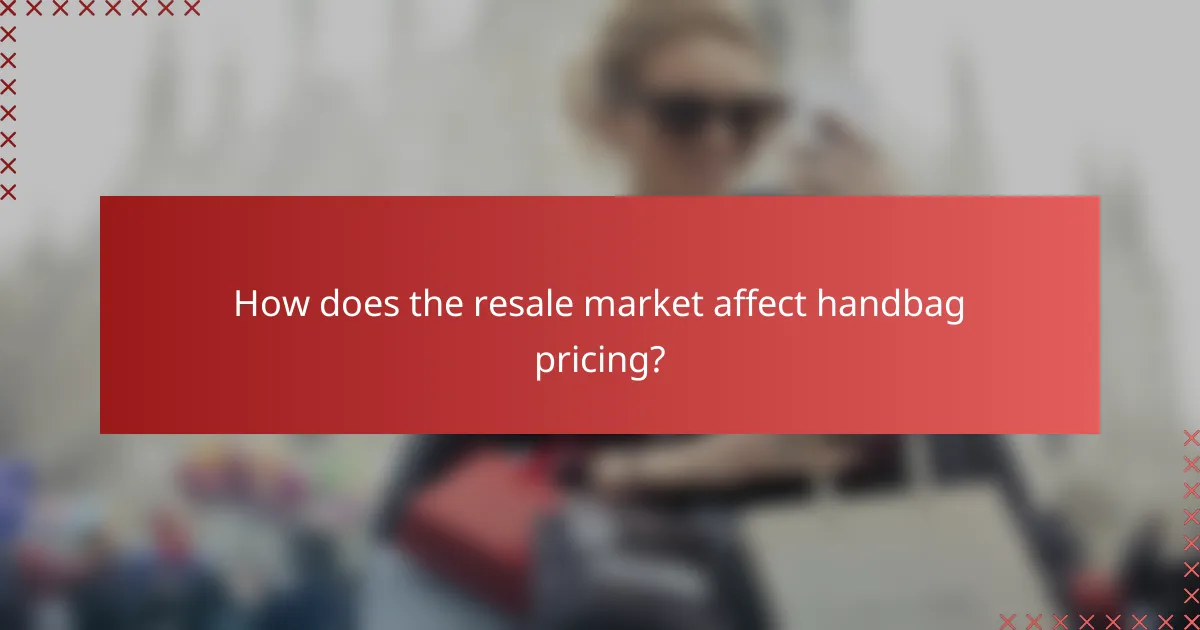
How does the resale market affect handbag pricing?
The resale market significantly influences handbag pricing by creating a dynamic where supply and demand dictate value. As luxury handbags are resold, their prices can fluctuate based on brand reputation, condition, and market trends.
Impact of brand reputation
Brand reputation plays a crucial role in determining the resale value of handbags. High-end brands like Chanel, Louis Vuitton, and Hermès often maintain strong resale prices due to their established prestige and desirability. Conversely, lesser-known brands may struggle to retain value in the resale market.
When assessing a handbag’s potential resale value, consider the brand’s history, customer loyalty, and market presence. Handbags from brands with a strong heritage or limited editions tend to appreciate more than those from brands without a solid reputation.
Trends in luxury resale platforms
Luxury resale platforms have transformed how handbags are bought and sold, impacting pricing strategies. Websites like The RealReal and Vestiaire Collective have made it easier for consumers to access authenticated luxury items, often leading to increased competition and price adjustments.
Current trends show that handbags in excellent condition with original packaging and documentation fetch higher prices. Sellers should keep an eye on platform trends, such as seasonal demand spikes or popular styles, to optimize their selling strategies and pricing.
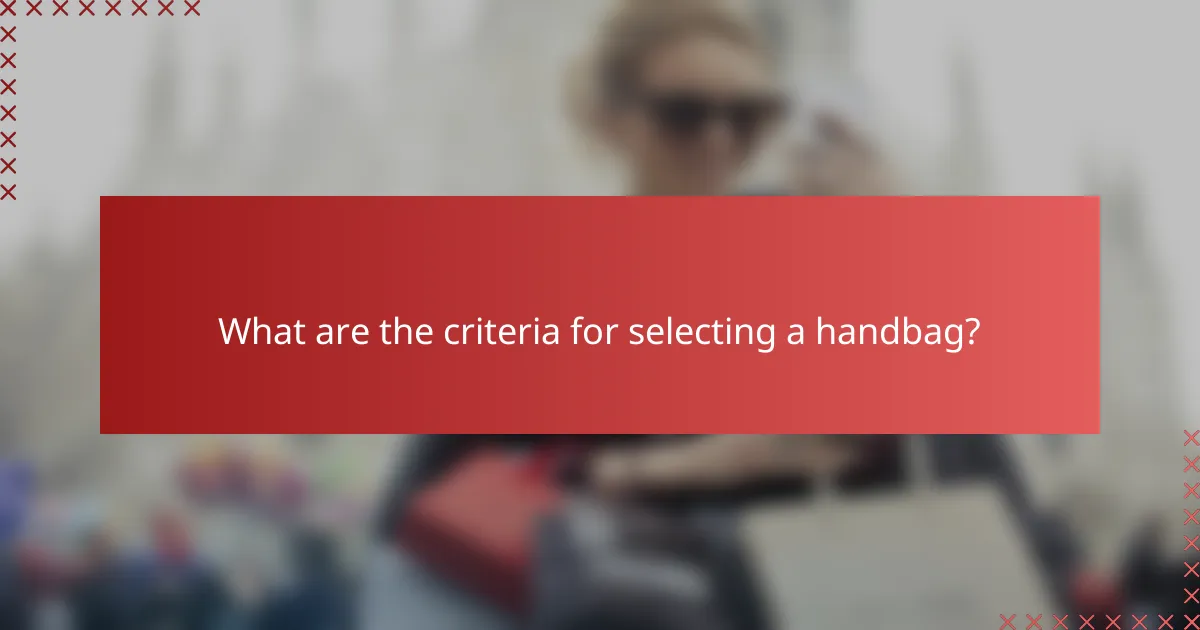
What are the criteria for selecting a handbag?
Selecting a handbag involves evaluating several key criteria, including quality, brand reputation, design, functionality, and price. Understanding these factors can help you make a more informed purchase and avoid overpaying for a handbag.
Quality of Materials
The quality of materials used in a handbag significantly impacts its durability and overall appeal. Look for handbags made from genuine leather, high-grade fabrics, or sustainable materials that offer longevity. Checking for stitching quality and hardware durability can also indicate the craftsmanship behind the product.
When assessing quality, consider brands known for their commitment to using premium materials. This often correlates with a higher price point, but it can also mean a longer-lasting investment.
Brand Reputation
Brand reputation plays a crucial role in handbag selection, as established brands often have a history of quality and customer satisfaction. Researching customer reviews and brand history can provide insights into whether a brand is worth the investment.
Be cautious of trendy brands that may charge a premium without delivering on quality. A well-regarded brand may justify a higher price due to its reputation for excellence and customer service.
Design and Functionality
The design and functionality of a handbag are essential for ensuring it meets your needs. Consider the size, shape, and style that best fit your lifestyle, whether you need a spacious tote for daily use or a compact clutch for special occasions.
Evaluate how well the handbag accommodates your essentials. Features like multiple compartments, adjustable straps, and ease of access can enhance usability and justify the price.
Price Comparison
Price comparison is vital when selecting a handbag to ensure you’re getting value for your money. Research similar styles across different brands to gauge a reasonable price range. High-end handbags can vary widely, from a few hundred to several thousand dollars.
Keep an eye out for sales or seasonal discounts, which can significantly reduce the cost. However, be wary of deals that seem too good to be true, as they may indicate lower quality or counterfeit products.
